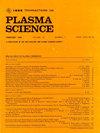基于分形理论的流道曲率半径对流道分布特性的影响
IF 1.5
4区 物理与天体物理
Q3 PHYSICS, FLUIDS & PLASMAS
引用次数: 0
摘要
在气体放电中,经常观察到放电通道分岔的现象。为了进一步了解通道分叉的特性,本文基于分形理论建立了针板气隙分形介质击穿模拟模型。利用有限元法求解了空间电势,揭示了放电过程中通道的整体形态变化和电场分布。此外,还分析了针电极曲率半径的变化对放电通道分布特性的影响,并通过实验进行了验证。结果表明,通道分支的形成使峰值电场减弱,且随着通道分支距离的增加,这种影响逐渐减弱。当尖端曲率半径在50 ~ 200~\mu $ m范围内时,半径越大,通道内电场越小,通道分支分布越广,分支数量越多,分形维数越高。相反,当尖端曲率半径在200 ~ 500~ $ $ m范围内时,半径越大,放电通道行为呈相反趋势,分形维数减小。本文章由计算机程序翻译,如有差异,请以英文原文为准。
Effect of Curvature Radius on Distribution Characteristics of Streamer Discharge Channels Based on Fractal Theory
In gas discharge, the phenomenon of discharge channel bifurcation is often observed. To further understand the characteristics of channel bifurcation, this article establishes a fractal medium breakdown simulation model for the air gap of the needle plate based on fractal theory. The spatial potential is solved using the finite element method (FEM), revealing the overall morphological changes of the channel and the distribution of the electric field during discharge. Additionally, the impact of changes in the curvature radius of the needle electrode on the discharge channel distribution characteristics is analyzed and verified through experiments. The results indicate that the formation of channel branches weakens the peak electric field, and this effect diminishes as the channel branching distance increases. When the radius of curvature of the tip ranges from 50 to $200~\mu $ m, a larger radius results in a lower electric field in the channel, a wider distribution of channel branches, an increased number of branches, and a higher fractal dimension. Conversely, when the radius of curvature of the tip ranges from 200 to $500~\mu $ m, a larger radius leads to an opposite trend in the discharge channel behavior, with a decreased fractal dimension.
求助全文
通过发布文献求助,成功后即可免费获取论文全文。
去求助
来源期刊

IEEE Transactions on Plasma Science
物理-物理:流体与等离子体
CiteScore
3.00
自引率
20.00%
发文量
538
审稿时长
3.8 months
期刊介绍:
The scope covers all aspects of the theory and application of plasma science. It includes the following areas: magnetohydrodynamics; thermionics and plasma diodes; basic plasma phenomena; gaseous electronics; microwave/plasma interaction; electron, ion, and plasma sources; space plasmas; intense electron and ion beams; laser-plasma interactions; plasma diagnostics; plasma chemistry and processing; solid-state plasmas; plasma heating; plasma for controlled fusion research; high energy density plasmas; industrial/commercial applications of plasma physics; plasma waves and instabilities; and high power microwave and submillimeter wave generation.
 求助内容:
求助内容: 应助结果提醒方式:
应助结果提醒方式:


